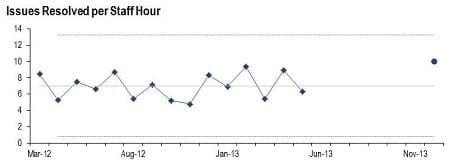Can You Set KPI Targets Using Historical Data?
by Stacey Barr |Measure Upsubscriber Suzanne asks “How do you set targets using historical data?” It’s a great question, because it acknowledges something that most people don’t appreciate about target setting.
To set a meaningful target, two things have to happen first.
You need to have a well-designed measure.
If your measure (or KPI) is vague and doesn’t clearly define what exactly is being quantified, you have no hope of setting a meaningful target.
At best, with a poorly designed measure like ‘Staff Productivity’, your target will be something lame and non-specific like “improve performance by 20%”. Bleh. Improve what exactly?
When you have a well-designed measure, like ‘Issues Resolved per Staff Hour’, your target can be so much more focusing: “Increase ‘Issues Resolved per Staff Hour’ from 7 to 10 by December 2013”.
You need to know your measure’s baseline.
The baseline for your measure or KPI is simply the current level of performance from which you want to improve. Historic data is essential in establishing the baseline.
The baseline is NOT the current month’s performance. You can’t pretend that routine variation doesn’t exist; you have to take it into account when you’re working out your baseline.
The best way to use historic data to establish your baseline is to use the Central Line of your measure’s XmR chart (or Smart Chart) as the baseline.

When you have your baseline established, you can then see where you’re starting from, and that makes it easier to decide where to go to.
JOIN THE DISCUSSION:
How does your company or organisation set targets? How well are those targets accepted by people, and how often are they achieved? Share your suggestions on the blog.
Connect with Stacey
Haven’t found what you’re looking for? Want more information? Fill out the form below and I’ll get in touch with you as soon as possible.
167 Eagle Street,
Brisbane Qld 4000,
Australia
ACN: 129953635
Director: Stacey Barr




